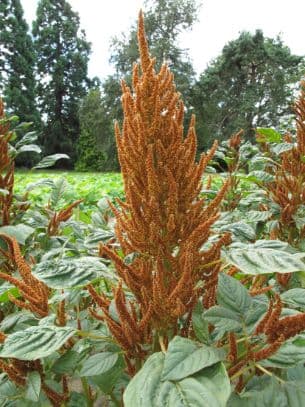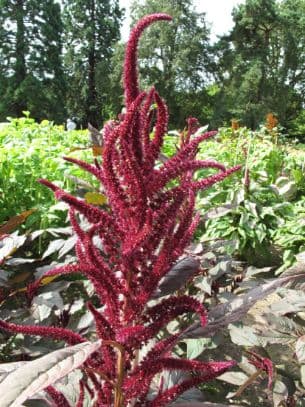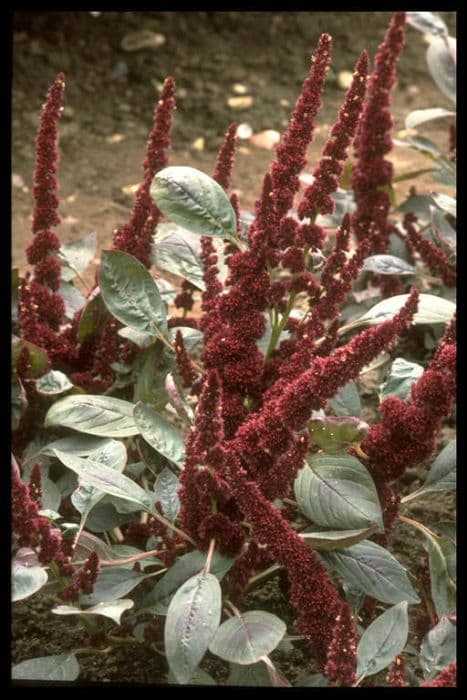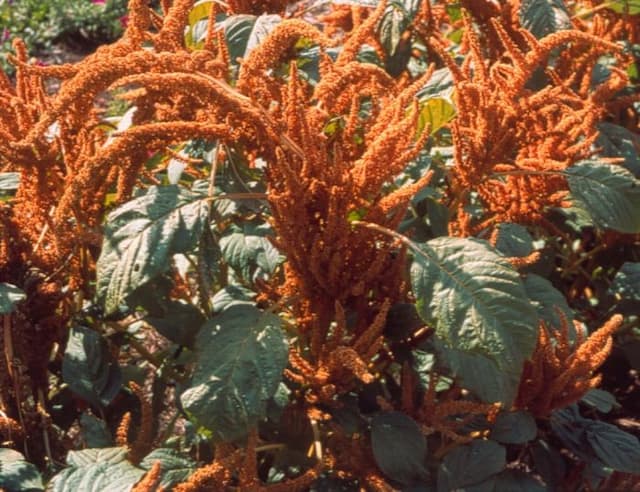Love-lies-bleeding Amaranthus paniculatus 'Marvel Bronze'

ABOUT
Amaranthus paniculatus 'Marvel Bronze', commonly known as Amaranth, showcases a striking appearance with its unique and vibrant foliage. The plant is characterized by its bronze-tinted leaves that provide a warm visual interest wherever it is grown. The leaves are often elongated and can display a mix of green and bronze hues that deepen in color with maturity, giving the plant a rich, lush look. Amaranth is also known for its flowering spikes which may bear a resemblance to cascading tails, these can come in various shades including reds, golds, or yellows that stand out against the foliage. The stems coordinating with the leaves, often bear the same bronze-green tones, contributing to the overall stunning aesthetic of the plant. This ornamental beauty is enjoyed for its colorful display and is a popular choice for both garden beds and as a cut flower in arrangements due to its unique texture and form.
About this plant
 Names
NamesFamily
Amaranthaceae.
Synonyms
Prince's Feather, Red Amaranth, Tassel Flower, Velvet Flower, Love-Lies-Bleeding, Foxtail Amaranth.
Common names
Amaranthus paniculatus, Amaranthus gangeticus, Amaranthus tricolor
 Toxicity
ToxicityTo humans
Commonly known as Amaranth, Amaranthus paniculatus 'Marvel Bronze' is not considered toxic to humans. In fact, many species of Amaranth are edible and consumed as leafy vegetables, grains, and ornamentals across various cultures worldwide. However, it's essential to note that some people may have sensitivities or allergies to certain plants. If someone is allergic to Amaranth and ingests it, they could potentially experience symptoms like itching, swelling, or gastrointestinal upset. It is always advisable to exercise caution and consult a healthcare professional if you suspect an allergy or if any adverse reactions occur after ingesting any part of the plant.
To pets
Amaranth, the common name for Amaranthus paniculatus 'Marvel Bronze', is generally considered non-toxic to pets such as dogs and cats. Though it is not commonly reported to cause serious harm to pets, individual animals might have different sensitivities or allergic reactions. As with humans, if a pet consumes a large amount of the plant and shows any signs of distress, such as vomiting, diarrhea, or unusual lethargy, it's important to seek veterinary care promptly. However, under normal circumstances, ingesting parts of the Amaranth plant should not cause major issues for pets.
 Characteristics
CharacteristicsLife cycle
Annuals
Foliage type
Deciduous
Color of leaves
Bronze
Flower color
Red
Height
3 feet [0.91 meters]
Spread
2 feet [0.61 meters]
Plant type
Herb
Hardiness zones
2
Native area
Central America South America
Benefits
 General Benefits
General Benefits- Ornamental appeal: The striking bronze foliage and showy flower spikes add aesthetic value to gardens.
- Drought tolerance: It is quite resilient to dry periods, which makes it suitable for xeriscaping.
- Easy to grow: Requires minimal maintenance and can thrive in a range of soil types, including poor soils.
- Heat resistance: Can tolerate high temperatures, making it a good choice for hot climates.
- Edible parts: Although excluded for this list, certain parts can be consumed.
- Fast-growing: Reaches maturity quickly, which is great for landscaping projects that need to establish vegetation fast.
- Attracts pollinators: The flowers attract bees, butterflies, and other beneficial insects that promote a healthy ecosystem.
 Medical Properties
Medical PropertiesThis plant is not used for medical purposes.
 Air-purifying Qualities
Air-purifying QualitiesThis plant is not specifically known for air purifying qualities.
 Other Uses
Other Uses- Amaranthus, commonly known as Amaranth, can be used as a natural dye for fabrics and foods, owing to its vibrant color.
- The seeds of the Amaranth plant can be popped like popcorn and used as a crunchy garnish on various dishes.
- In floral arrangements, Amaranth's cascading plumes provide a unique texture and rich color, often lasting longer than other fresh-cut flowers.
- The leaves of the Amaranth plant are rich in nutrients and can be used as fodder for livestock, providing an alternative food source for farmers.
- Amaranth flour, made from ground seeds, is gluten-free and can be used in baking to accommodate those with gluten sensitivities.
- As a symbol of immortality in ancient cultures, Amaranth is used in ceremonial decorations and rituals to express the enduring nature of life.
- In crafting, the dried flowers and stems of Amaranth can be incorporated into homemade paper to create a textured and decorative finish.
- The plant's vibrant appearance makes it a popular choice for ornamental gardens, where it can contribute to a variety of aesthetic landscapes.
- Amaranth plants can be used for biofuel production, as their high biomass yield makes them a potential resource for sustainable energy.
- The tough, fibrous stems of mature Amaranth plants can be used in basketweaving and other fiber arts for creating sturdy, natural crafts.
Interesting Facts
 Feng Shui
Feng ShuiThe Love-lies-bleeding is not used in Feng Shui practice.
 Zodiac Sign Compitability
Zodiac Sign CompitabilityThe Love-lies-bleeding is not used in astrology practice.
 Plant Symbolism
Plant Symbolism- Immortality: "Amaranth" is derived from the Greek word "amarantos" meaning "one that does not wither," or the "never-fading." This represents immortality and the idea of an enduring legacy.
- Unfading Love: The enduring nature of the plant, which does not readily wilt, symbolizes an everlasting or unfading love.
- Devotion and Integrity: In some cultures, amaranth flowers are given as tokens to represent earnest and faithful devotion, highlighting the importance of integrity in relationships.
- Heart's Ease: In Victorian floriography, or the language of flowers, amaranth represented the comfort and solace offered by the "true heart," suggesting emotional support and ease of heart.
 Water
WaterFor the plant commonly known as Summer Poinsettia, water thoroughly to ensure the soil is evenly moist, which typically means about 1 to 2 inches of water per week. During hot, dry periods, you may need to water the plant more frequently, possibly every other day, to prevent the soil from drying out. Ensure that the pot or area where Summer Poinsettia is planted has adequate drainage to avoid waterlogging, as this could lead to root rot. For potted plants, watering until excess water runs out of the drainage holes is a good practice. Adjust watering based on rainfall and temperature changes; during cooler or rainy weeks, you may need to water less often.
 Light
LightSummer Poinsettia thrives in full sun conditions, so place the plant in a location where it will receive direct sunlight for at least six to eight hours per day. It can tolerate some light shade, but too much shade may result in leggy growth and fewer flowers. Ensure it's in a spot that's protected from strong, drying winds, which can stress the plant and affect its growth.
 Temperature
TemperatureSummer Poinsettia prefers warm temperatures and is sensitive to cold. It can survive in temperatures as low as 50 degrees Fahrenheit and as high as around 90 degrees Fahrenheit. For optimal growth, maintain an environment where the temperature hovers between 65 and 80 degrees Fahrenheit. This plant is not frost-tolerant, so if you live in a region with cold winters, it should be grown as an annual or moved indoors before the first frost.
 Pruning
PruningPrune Summer Poinsettia to maintain its shape and encourage bushier growth. Prune it by cutting back the tips of the stems throughout the growing season. Regular pruning, about once every three to four weeks, also helps to promote more plentiful blooms. The best time for major pruning is in the late winter or early spring before new growth begins, but light pruning can be done at any time during the growing season.
 Cleaning
CleaningAs needed
 Soil
SoilLove-Lies-Bleeding thrives in a well-draining soil mix with good aeration, consisting of one part garden soil, one part peat or coco coir, and one part perlite or sand. The ideal soil pH should be slightly acidic to neutral, between 6.0 and 7.5.
 Repotting
RepottingLove-Lies-Bleeding should be repotted annually or when it becomes root-bound. Younger plants might require more frequent repotting. If growing as an annual, repotting may not be necessary.
 Humidity & Misting
Humidity & MistingLove-Lies-Bleeding prefers moderate humidity levels but is adaptable to various conditions. Aim for a humidity level between 40-60%.
 Suitable locations
Suitable locationsIndoor
Provide bright light and good air circulation for Love-Lies-Bleeding.
Outdoor
Plant in full sun and space adequately for Love-Lies-Bleeding.
Hardiness zone
2-11 USDA
 Life cycle
Life cycleAmaranthus paniculatus 'Marvel Bronze', commonly known as Summer Poinsettia or Joseph's Coat, starts its life cycle with seed germination, which occurs at warm temperatures between 18 to 24°C (65 to 75°F) and typically takes 7 to 14 days. Upon sprouting, the seedling goes through a vegetative growth stage, developing a root system and foliage with the characteristic bronze-red leaves over a few weeks. This annual plant continues to grow rapidly and can reach a height of 2 to 4 feet, depending on conditions. During its reproductive phase, which occurs in the late summer or early fall, it produces clusters of tiny, inconspicuous flowers, which are often overshadowed by the vibrant leaves. After pollination, the plant sets seed, which matures and is released as the plant begins to wilt and eventually dies with the onset of cooler temperatures. The cycle can start anew as seeds lie dormant through the winter, or they can be collected and sown the following spring.
 Propogation
PropogationPropogation time
Spring-Early Summer
Amaranthus paniculatus 'Marvel Bronze', commonly known as Summer Poinsettia, is best propagated by seed. Sowing can be done in early spring once the danger of frost has passed, or seeds can be started indoors about 6 to 8 weeks before the last expected frost date. To propagate, seeds should be scattered onto the surface of a well-draining soil mix and pressed lightly into the soil, as they need light to germinate. The soil should be kept moist, but not waterlogged, and the seeds will usually germinate within 7 to 14 days at a temperature around 70°F (21°C). Once seedlings have developed their first set of true leaves and are large enough to handle, they can be transplanted to their final location, spacing them about 10 to 18 inches (25 to 45 centimeters) apart to allow for adequate air circulation and growth.









